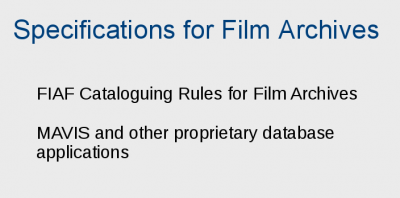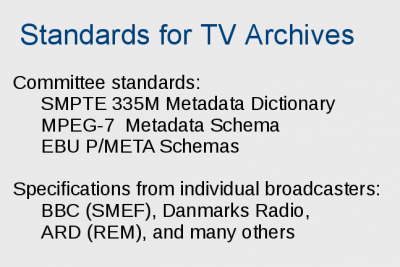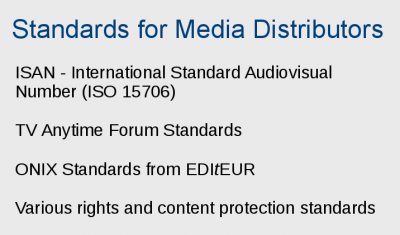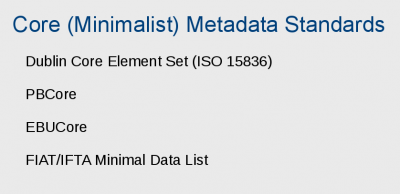From the TC 372 Workshop Compendium
Metadata about audiovisual media comes in many shapes. Depending on the usage context, it can focus on the physical or digital artefact, the public release, the artistic creation, the commercial product, the historical evidence, or whatever.
So far, only few efforts have been untertaken to integrate at least some of these contexts within a metadata specification.

|
Few guidelines and specification address the work of film archives directly.
The FIAF rules were published in 1991. Encoding of elements follows ISBD, which is mainly a presentation syntax. A major revision based on the recently published RDA is in progress.
MAVIS is the only major database application specifically designed for firm archives. It uses a detailed data model centered around two main entities: the content of a film and its carrier. The manufacturers of MAVIS went out of business in 2007.
Most other cataloguing applications for film archives are client-specific configurarions of database or document management systems.
|

|
Most committee standards from the television sector have a strong focus on the digital production and distribution chain. Most TV broadcasters use these standards selectively, e.g. when supported by digital video production equipment and systems.
In-house metadata specifications are common and some of them are highly complex data models.
|

|
ISAN is a numbering scheme for audiovisual media products similar to the ISBN for books. Members of the ISAN committee have contributed to the CEN standardisation process.
TV Anytime was an industry initiative that has produced a number of. MPEG-7 compatible metadata definitions for use with consumer devices such as digital video recorders.
ONIX is a series of metadata standards for the publishing industry and the book trade.
Numerous specifications exist for expressing rights and restrictions as metadata, usually for embedding in digital media objects.
|

|
Dublin Core is an ubiqitous standard applied to all kinds of digital resources. Using it for cinematographic works is problematic, however, since e.g. the notion of creator does not match well with the notions of cast and credits.
PBCore is a simple schema used for metadata exchange among public broadcasters in the U.S.
EBUCore is a minimalist counterpart to P/Meta, recently introduced by the European Broadcastung Union.
The FIAT/IFTA data element list is a members-only document.
EN 15744 can also be regarded as a core or minimalist standard.
|



